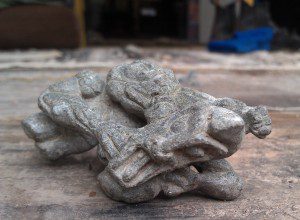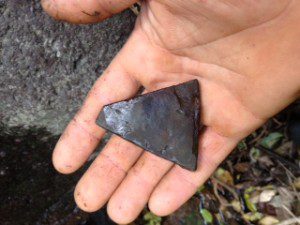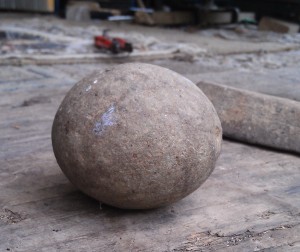By Steven Strong
Contributing Writers for Wake Up World
I have often written about the amazing archaeology and some, but not all, of the associated rock arrangements at Adam’s Garden (the Emu’s Nest), and the site’s relationship to the nearby Standing Stones. But amongst all of the discussion of this remarkable site, at no stage have I explained why we named the site after Adam.
Well before he took me to the creek bank at the site, it was obvious Adam Pippen had a special relationship with the land. Unaffected by dogma or ego, Adam moves with the land, and is always at its beck and call. He had found the site earlier but, to ensure the site was both protected and properly investigated, he waited until the timing and personnel were right to disclose any details.
The reason Adam came upon this sacred site is no different to why he has found so many other unusual rocks and Original sites: because he was meant to. This may seem a bold statement to make, but his affinity with the land is irrefutable, the hard evidence compelling, and we are left with no other reasonable explanation.
[pro_ad_display_adzone id=”110028″]
Of the seven decidedly unnatural rocks I will present today, two have already been discussed in relation to other sites, and because of this will be covered briefly, and the others will be discussed in detail with accompanying photographs.
I will also introduce a fascinating new site at which our investigation has just commenced.
In advance of this article, I offer my apologies to Adam as time and space allows for only a relatively small sampling of his amazing collection of wares.
Adam’s Amazing Artefacts
The Combat Stone
Without doubt the most enigmatic and exquisite rock carving Adam holds in custodianship is an 8 cm (3.1”) carving of two men or beings in combat.
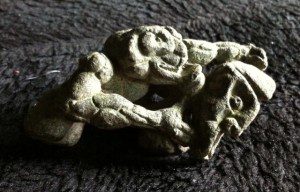 In an attempt to determine its origins, I sought out some of the top academics specializing is Maori and Pacific Islander technology and culture, and they were no less than perplexed by this carving, unable to offer any clues as to its origin. They did agree however that the degree of sophistication exhibited in this carving was well beyond the reach of any known Indigenous tribe of the Southern Pacific.
In an attempt to determine its origins, I sought out some of the top academics specializing is Maori and Pacific Islander technology and culture, and they were no less than perplexed by this carving, unable to offer any clues as to its origin. They did agree however that the degree of sophistication exhibited in this carving was well beyond the reach of any known Indigenous tribe of the Southern Pacific.
The Stone Cap
As I discussed previously, the seven sided stone, used as a cap-stone at the Standing Stones site, is no less challenging when we consider which resident technologies could come close to creating this geometric language marker. It lacks any vestige of a percussion point on any of its seven smooth and flat faces – a characteristic shared by all creations of rock and stick technology. At the very least, metal was used to create such flat and perfect surfaces, and what is equally mystifying, is that some of these rocks are so hard that softer metals such as iron, brass or copper are simply not up to this task. Similarly, bulbs are also absent on every rock examined both here and in the surrounding area.
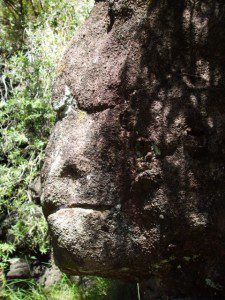
Now onto a site that most of our team have not yet been able to visit… except of course, Adam.
The Ape Face
Among Adam’s photographs of this site is a picture of a rock formation that looks incredibly ape-like. We first saw pictures of this carving when sharing with Adam a gallery of photographs depicting Thoth, some in ibis and ape form, and it was immediately undeniable that his riposte was no less impressive. But there was one caveat.
Found in the thick rainforest and on the side of steep slope, this carving is located in an incredibly difficult location to access. The last time Evan and I went out into country with Adam was unlike any expedition before, after or ever, in this life or ones yet to come. Visions of that last trek still haunt both of us, and so, anticipating a similar experience at this new site, we offered a somewhat cowardly promise to join Adam on site “sometime in the future”.
In the meantime, the photographs of this rock, shaped into a decidedly ape-like face, along with the assurances of its authenticity from the only person to have been to the site, is enough. And it certainly raises the cumulative bar.
The Triangular Stone
In the same vein, the second of Adam’s unseen pieces of archaeology is at rest and still in situ somewhere within the rock wall of a remote waterfall.
… and once again, Evan and I must plead guilty of avoidance. Being wedged into a rock-face, this triangular shaped rock relic is located somewhere amongst a series of waterfalls, the problem being that the same first incursion into utter dread and fear of broken limb or worse, led by Adam, also involved climbing up many steep waterfalls.
For now, this is a task suspended in abeyance. We will get around to it, but in the meantime, Adam’s integrity and photographs are more than sufficient as introductory evidence. And it begs the questions: How was this remarkably angular stone shaped? By whom? And for what purpose was it used?
The Spherical Stone
I have no doubt that those of a cynical inclination will allege the incredibly smooth face on this near-spherical rock is solely due to natural processes. Without doubt it is possible that nature is at play, but we are working within a contextual framework, and this rock must therefore be recognised as part of a package.
Evan and I have held it in our hands many times; there is not a crack or fracture and the grain looks almost polished. On its own it is at best a “maybe”, but viewed in association with the thousands of unnaturally shaped rocks found in the immediate area, the chances are much greater that this rock was artificially shaped.
The Sandstone Block
So too the sandstone block we feel was used in constructing a building or wall. It features too many level surfaces and ninety degree angles for this to be a purely random act of nature. Although the edges are now worn, with the benefit of sighting and comparing many other shaped rocks that were less eroded and have edges capable of drawing blood, we believe that originally this building block would have also had sharp edges.
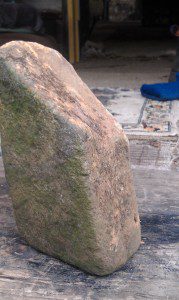
As is the rule without exception, both of these stone relics display no sign of any rock-on-rock percussion or technology.
And now, onto the new site….
An Introduction to the Stone Gully
This one is still a work in progress. Adam had made some brief allusions to a series of sizeable rock structures at another site, but on each occasion he stirred our curiosity in that direction, something else seem came up. The timing just wasn’t quite right…. but it is now.
Admittedly, one thirty minute inspection of less than a quarter of these ancient structures just isn’t enough. Nor is there any point posting photographs until a full assessment of the site is done, consultation with Original custodians occurs and measurements and alignments are thoroughly recorded. But there some very basic observations that will stand true throughout whatever work takes place.
At this site I saw three, possibly four stone arrangements, some bearing stones of considerable weight. But all of this paled by comparison (and tonnage) once Adam directed my attention to a gully running down the side of a heavily forested slope. It wasn’t a huge divide; on some sections it barely separated a five metre slope on either bank. But what ls deposited in this gully was far more significant.
There is a massive collection of huge igneous rocks piled into one section of the gully which by my estimation is at least one hundred metres (328 ft) in length. The problem is that the surrounding slopes into the gully are so small that if we were able to take all the rocks sitting in the gully and place them on the slopes, they would fully cover the slope and spill over both sides. These rocks, many of which must weigh over 500 kilograms (1,100 lbs), could not have originated from the side slopes, and therefore had to be moved some distance before placement in the gully.
The first question that arose relates to who did this? The obvious response, once factoring in the technology required, is that people from a non-Original society were on this slope. Machinery, nothing less than a bulldozer with a large blade, is the bare minimum needed for such an excavation. But what purpose could this serve? Banana farms are all around, and at first glance the possibility of clearing land seems the most logical explanation. The problem with this theory is that, in the past, banana growing never generated a good income. Such an endeavour serves no economic goal, requiring hundreds of hours of hard labour with no prospect of a financial return. It is an avenue we need to pursue, but the inordinate amount of time and effort required to move these massive stones demands a compelling reason as to why any banana farmer would go to this amount of trouble to protect one tiny gully from erosion and leave all the rest unprotected.
When I first sighted this collection of stones snaking up the slope, my immediate reaction was to compare the 500 kilogram igneous rocks that have been placed in this gully to the rocks supporting the road that leads down to Adam’s Garden, and came up with the same answer: there is no difference.
After extensive consultation with my research collaborators, we see this construction as yet another part of an ancient and sacred complex that spreads across what was once the largest stand of sub-tropical rainforest in the world. We can prove through Original oral accounts and extensive documentation that Clever-fellas and Kadaitcha Men came from all over Australia to dance, sing and give ceremony at the Standing Stones. We also know that many of these highly advanced men came back to this country as they prepared to die and cross over to the Spirit realm.
What drew them from all over the continent? Who began this tradition? What other sites remain hidden? And how much of this knowledge is still available? These are questions our team are working to answer…. and we still have some considerable way to go.
About the authors:
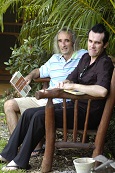 Steven Strong is an Australian-based researcher, author and former high school teacher. Evan Strong is a researcher, historian and author with a Bachelor degree in the Social Sciences. Their work is to explore the ancient story of the Original people, a narrative that was almost lost to aggressive European colonisation.
Steven Strong is an Australian-based researcher, author and former high school teacher. Evan Strong is a researcher, historian and author with a Bachelor degree in the Social Sciences. Their work is to explore the ancient story of the Original people, a narrative that was almost lost to aggressive European colonisation.
Edited and additional commentary by Andy Whiteley for Wake Up World.
This article and all images contained herein © Adam Pippen.
[pro_ad_display_adzone id=”110027″]

